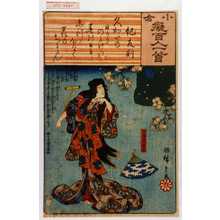Japanischer Druck "Ki no Tomonori" von Utagawa Hiroshige
Künstler:Utagawa Hiroshige
Titel:Ki no Tomonori
Datum:c. 1847
Details:Mehr Informationen...
Quelle:Honolulu Museum of Art
Durchsuchen aller 5.476 Drucke...
Beschreibung:
This print was conserved with the support of the Robert F. Lange Foundation. On a peaceful day so warm in the tranquil light of the springtime sun how is it that the blossoms fall with so little sense of calm? (translation by Steven D. Carter) Ki no Tomonori (d. 905) was a prominent court poet, and one of the four compilers of the Kokin Wakashü (Collection of Poems Ancient and Modern, 905), the first of eight imperially commissioned poetry anthologies compiled during the Heian period (794-1185). Though he passed away shortly before the anthology was completed, Tomonori contributed a traditional Chinese preface and a large number of notable poems to this collection, one of which was eventually included in One Hundred Poems by One Hundred Poets. Tomonori's original poem, featured in the striped cartouche at top, captures the fleeting beauty of a warm spring day, where everything but the soft sunlight and fluttering cherry petals is suspended in stillness. However, in its revisualization by Hiroshige, the spring motif of cherry blossoms is tied to an actual scene from the popular Noh play Miidera (ca. 15th century). In this play, a mother driven insane by the disappearance of her child is led by divine inspiration to Miidera Temple, where her deranged hopes of finding him cause her to strike the temple's bell. Here Hiroshige portrays the "Madwoman of Miidera" as she sings of the evanescence of spring, her gaze fixed on the bell surrounded by scattering cherry blossoms. Though the paper fan is a prop from the actual play, Hiroshige has also given the madwoman a mallet for striking the bell. The details of her plight are summarized in the upper left corner of the illustration by Ryükatei Tanekazu (1807-1858), a popular fiction writer of the time.







